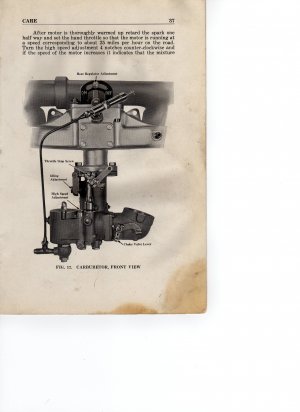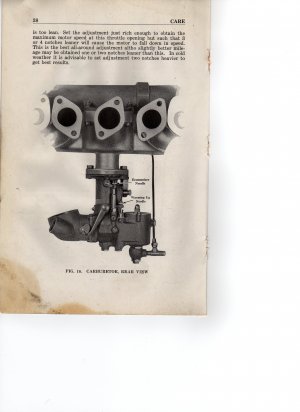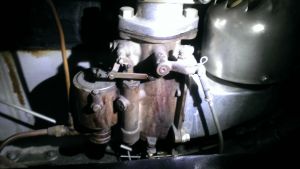- Home
- About Us
- Join/Renew
- Member Benefits
- Member Pages
- Log In
- Help
- Museum Store
Hi looking for any information available in respect of correct settings and adjustments to the carb on my 1928 series 81 would appreciate input/advice
many thanks
The initial settings for the Stromberg 03 carburetor are:
Main jet unscrewed 2 1/2 turns
Idle jet unscrewed 1 turn.
The main jet creates a richer mixture when Unscrewed [counter clockwise.
The idle jet is the reverse, it is an air jet not fuel, so it creates a richer mixture when turned IN, that’s clockwise.
Currently I have an 03 running with exactly 2 1/2 turns out on the main, but the idle needs to be at about 2 full turns out to not be too rich, so the idle initial setting is different than the owners manual states.
Make sure your choke lever is fully open and that the choke lever-enrichment jet is fully seated, leaving about 1/32″ clearance from the lever to the nut on the enrichment jet.
Hope this helps.
Greg Long”
Do you have the Owners manual? THe adjustments are listed there. Greg is correct on his comments, but if you need a copy of the pages (the pictures are helpful to some of us), see attached.
Best,
Peter Williams

Here is the second picture!
Best,
Peter Williams

Hello,
I took my car to an event this weekend and the Carb has moisture on the bottom and it doesn’t seem to be gaining enough power. Is it normal to have some moisture and if not who is recommended to rebuild and adjust the Carb? Are there rebuild kits and about how much to rebuild?
Thank you,
Ken

Ken,
You have the Series 80 carb on your car and I DK on adjustments with that carb, as I run a Series 81 Stromberg O-3 on my Series 80.
It sounds like it is running too rich (more fuel than needed – maybe causing the moisture).
You can do the adjustment and then rev the engine and see where it increases engine speed without a POP and without it bogging down.
Then, if you decide to send it for rebuild, these are the guys to do the rebuild.
Classic Carburetors
3217 East Shea Boulevard
#440
Phoenix, Arizona 85028
Peter
Ken,
I forgot to post the telephone number for Classic Carb: (602) 971-3300.
Give them a call.
I know that they did a carb or two for Wayne Hancock.
I believe that the rebuild cost about $600.00, but it now runs like a champ.
Peter
Classic Carb did the Stromberg OX-2 on my Rickenbacker and they did a fantastic job.
The car runs great and the carb looks like new.
Thank you Peter and Craig,
Is my Carb the Stromberg OX-2? I will try to adjust it.
Is the Petcock supposed to be hard to turn for the Fuel Flow to the Carb?
I have to use just about all of my strength to turn the valve.
Ken
The carb in your picture does not look like an OX-2.
And no, your petcock should not be that hard to turn.
There should be some lettering on the side of the carb or someone else here can identify exactly what you have.
Craig,
I don’t see any letters on the carb that would Identify it. On the top plate it does say Pierce Arrow Pat Pending.
I will see if I can adjust the spring on the petcock to see if I can make it easier to move.
Thank you,
Ken
Before you adjust the spring, I would give the moving parts a spray of Aerokroil, CRC 5-56 or one of your favorite penetrants. Let it sit for a while, and see if it helps. Loosening the spring can cause air leaks. The better approach is to find the source of the resistance. I would not use silicone, it will cause issues, such as the inability of the carb and anything the silicone touches, to accept paint.
I believe that the Series 80 carb, although a Stromberg is not marked in the side as with most Stromberg updraft carbs.
I believe that it was made specifically by Stromberg for the PAMCC.
I run a Stromberg O-3 on my Series 80.
It is what PAMCC ran on the Series 81.
The O-3 and all of the other Stromberg carbs that I purchased to ransack for the floats, are all clearly marked cast with the model number on the side, at the bottom of the throat.
The model number (M-1, L-1, O-2) is on the side that faces out when the carb is mounted.
I guess it was done that way so that any mechanic could identify it, without removing the carb.
Bob,
Thank you for the advice. I will give it a shot of Aerokroil.
Ken
Hi Ken, these carburetors are simple units, simpler than the carburetor on your lawn mower or chainsaw. And, often the problems with the way an engine is running are caused by other factors like points, clogged filters, poor fuel, etc. The carbs usually do not ‘fall out of tune’ .
Ken, when you mention ‘moisture’ on the bottom of the carb, is this fuel ‘moisture’? or water ‘moisture’ ?? If it is fuel, does the carb drip fuel when the engine is not running ?
Is the fuel only on the bottom of the carb? or does the throttle shaft get wet?
A common scenario is when the fuel is left on, and the car is not running, The float’s needle and seat leak a little, causing some fuel to collect in the bottom of the inside of the carb. When the car is started next, this extra fuel is pulled into the engine, and floods a spark plug or two..
The spark plugs sometimes will not clean themselves, and will stay fouled, making your engine a 4 or 5 cylinder engine instead of 6 cylinders running.
What I recommend first is to start the engine, and let it idle, using a long screwdriver with a plastic handle, touch each spark plug on the bare wire clip on the top of the plug, and at the same time touch the shaft of the screwdriver to another metal part of the engine, this will short out the spark-current to the plug. Do this to each spark plug, and listen to the engine.
If the spark plug is working and the cylinder is providing power, then when the spark plug is shorted, you will notice the engine miss and the rpm will slow. If you do not notice any difference in the engine running with the spark plug shorted, then that cylinder is not firing, and usually this is because of a fouled spark plug.
If you do have fouled spark plugs, I’d remove then and inspect them. The plugs that are firing will have brownish, dry center electrodes, the fouled plugs will be black, oily or shiny with unburnt fuel. Sometimes you can clean the fouled spark plugs by spraying them with carb-cleaner or brake-clean, and blowing them off with compressed air.
But I might be easier to just install a new set of spark plugs,, I recommend Automate 3076, they usually cost between $3-$4 each, Champion spark plugs in my experience are more likely to foul. Automate plugs seem to work better for me.
If you do not find a missing cylinder, remove the distributor cap, life tit carefully up, to clear the rotor’s tip, and inspect the points, they should have about .020″ gap. The rubbing block on the points often wears from not having any grease on the rotor or the rubbing block. When the block wears, the points close up, which retards the timing. Retarded timing will result in poor performance, lower power.
This should get you on the right track to discovering what is wrong with the engine..
Greg Long
Ken, when you mention ‘moisture’ on the bottom of the carb, is this fuel ‘moisture’? or water ‘moisture’ ?? If it is fuel, does the carb drip fuel when the engine is not running ?
Is the fuel only on the bottom of the carb? or does the throttle shaft get wet?
Greg,
It is Fuel Moisture and it was after we drove it for about 20 minutes to a show.
The only time I have noticed it was when we got to the Show. The rest of the time looks more like varnish.
The Fuel may have been coming from the screw up on top. I will run the car
to see if I can see if it drips while sitting. The driver that I had drive the car said he was having to run the car very rich to keep it moving at speed. He may not be the best at being the judge of how it runs because he did not shift down for going up hills.
On top of the manifold there is a intake adjustment that was all the way over to the right we have sense moved it to the center. I think the reason it was all the way over to the right is because the car was being ran in Tucson, Arizona where it was very hot. I am hopeful that this will help with some of the running issues.
I will check all of the other items you have suggested also.
Thank you,
Ken
Ken,
If the fuel is leaking from the center assembly on the top of the lid for the float tank, then you need to adjust the center screw / shaft (needle) on that lid, as it controls the needle shutoff for the float tank.
The car likely runs poorly because you are likely flooding the engine because of this necessary adjustment.
If the needle does not fit into the fuel shutoff hole soon enough, the float tank overfills and leaks through the top (and into the air intake and thus, the carb).
My Stromberg O-3 would drip fuel from the bottom of the air-horn.
If it shuts of too soon, there will be insufficient fuel in the float tank.
The method for adjustment of the shaft is to remove the acorn nut that fits over the center shaft / needle on the top (the acorn nut has a hole in each side), then notice that there is a tiny, tiny nut (or two) that lock the shaft in place.
On the top of the shaft there its a small slot for a small screwdriver.
You need to experiment, but the concept is to loosen the nut(s), hold them in a fixed position and screw in the shaft a tad.
Run the car and see if it leaks. If so, it needs another partial turn, unlock the nuts, turn, lock and repeat trial, repeat, repeat, repeat until satisfied.
I recall that I did this adjustment its the car running and tested the function by revving the engine to determine if it was bogging (flooding) or hesitating (too little fuel).
I believe that I first loosened the needle shaft until it flowed from the top. I then tightened the needle shaft until the flow stopped.
When you believe that you have it in the correct position, with the screwdriver IN PLACE, tighten the tiny nut to lock the needle in place.
Then run it more and you may find that you need to re-do it, because invariably the needle shaft will move a touch when you tighten the locking nuts.
Be patient and resolute.
Here is another hint: On the end of my float bowl there is a hex nut midway up the bowl. This nut is a fuel level gauge. If your car is on the flat with the carb properly adjusted, when you remove that nut, there should be no fuel dripping.
NOTE: If the needle shaft shuts off the fuel too early, the float bowl will not fill sufficiently to drip anywhere and you will have insufficient fuel flow to power the car.
Of course, all of this is done with the float installed.
Finally, NO SMOKING while doing this adjustment. HA!
I hope that this helps.
Peter
Ken,
BTW, when I first took my carb off to futz with it, I removed all of the hex nuts that I could and bought a box of red fiber washers to use when I reinstalled the nuts.
The carb did not leak in those locations before I removed them, nor now, but I the good compulsive tinkering side to my personality forced me to do it.
Peter
Peter,
Thank you for the information. It is very detailed and will come in handy for making the adjustments.
Ken
Pierce arrow made their own carburetors up until they used the Stromberg O-3 for the Series 81 in 1928.
The Series 80 carb usually does not have an externally adjustable float level, the collar that the ‘dod-bone’ levers move up and down on the needle are soldered on the needle, The stromberg O-3 was the first use of an externally adjustable needle.
The needle should never need adjusting, if the fuel rises to the top of the float chamber, either the needle is not sealing because of a bit of dirt, or the float has a crack and has gasoline inside the brass float, causing it to sink.
The Series 80 main-jet assembly is prone to leaking, it has a odd round gasket with several slots in it for fuel flow that is supposed to seal the jet housing to the bottom of the carb body, but it has a spring-steel strap to hold pressure on the gasket and jet assembly, and it often does not seal well,
And the actual jet shaft is a 1/8″ diameter steel shaft that has a miniature packing around the shaft, just like a water pump shaft and packing. it is just very small. And it also tends to leak a bit..
The best procedure would be to use some solvent like brake clean or carb cleaner, spray the bottom of the carb, then using a toothbrush type parts brush, remove as much of the crud on the jet assembly and carb as possible. If you have painted splash pans under the carb, you might want to cover them or be careful with the solvent, it might remove the paint on the pans.
With the carb cleaned, use a mirror and see if you can identify the source of the leak.. IF there is an actual leak.
The carb has a small, about 1/8″ drain hole in the bottom, near where the aluminum air-horn is screwed onto the carb. If your ‘driver’ had the engine running very rich, there is a lot of fuel in suspension and condensed on the intake manifold and inside of the carb body. This excess fuel will drain down to the bottom of the carb once the engine is shut off. Then it will exit the cabe via the drain hole, and make the car owner think the carb has a lack,, when it actually is running normally..
I’d suggest taking it out for a drive and run the mixture at normal settings, and see if you end up with the damp carb like before.
Your intake manifold is designed such that it is impossible to NOT have a lot of exhaust heating the manifold. The ‘HOT/COLD’ lever can be set on COLD and left there, unless you take the car up into the mountains and drive it in sub-freezing weather.
The intake manifold will still get very hot, hot enough to burn our hands/fingers, even with the lever on COLD.
Ken: I’d take ‘er out and drive ‘er, and see if it all goes away.. a bit of dampness is not a concern, but a steady drip, or puddle under the engine is.
Greg Long
